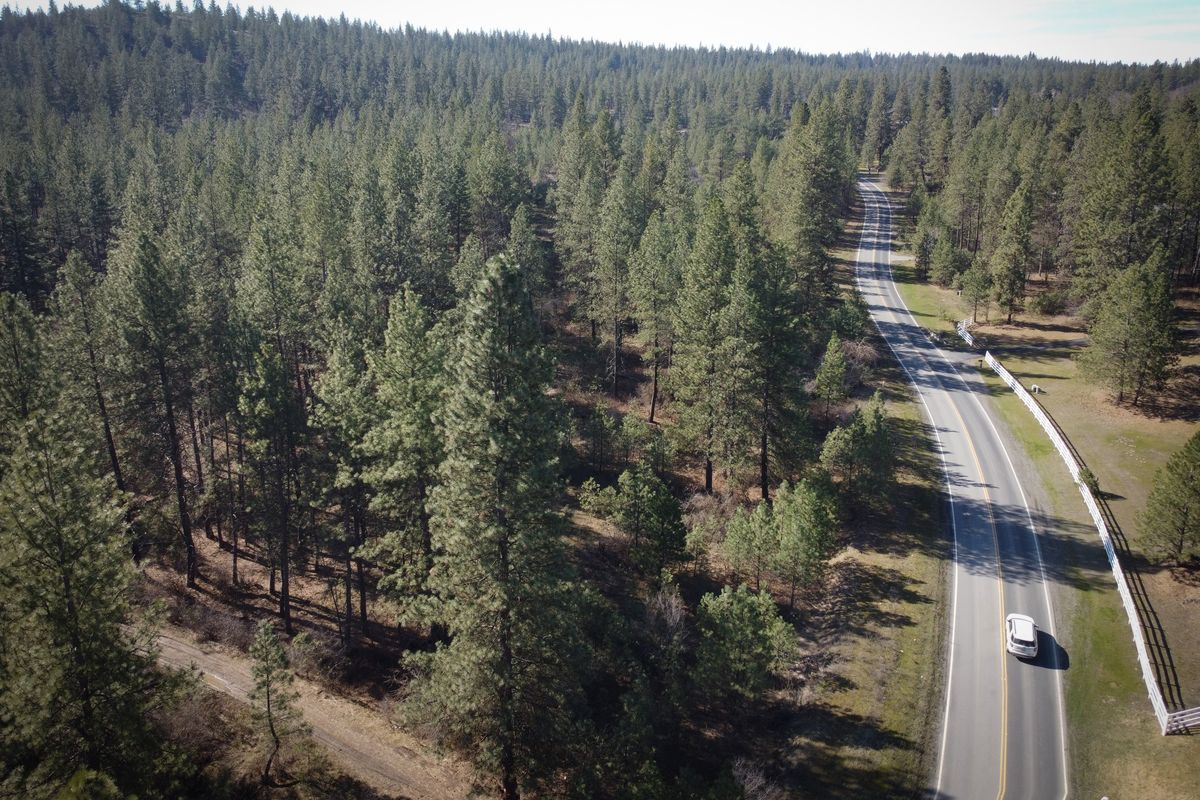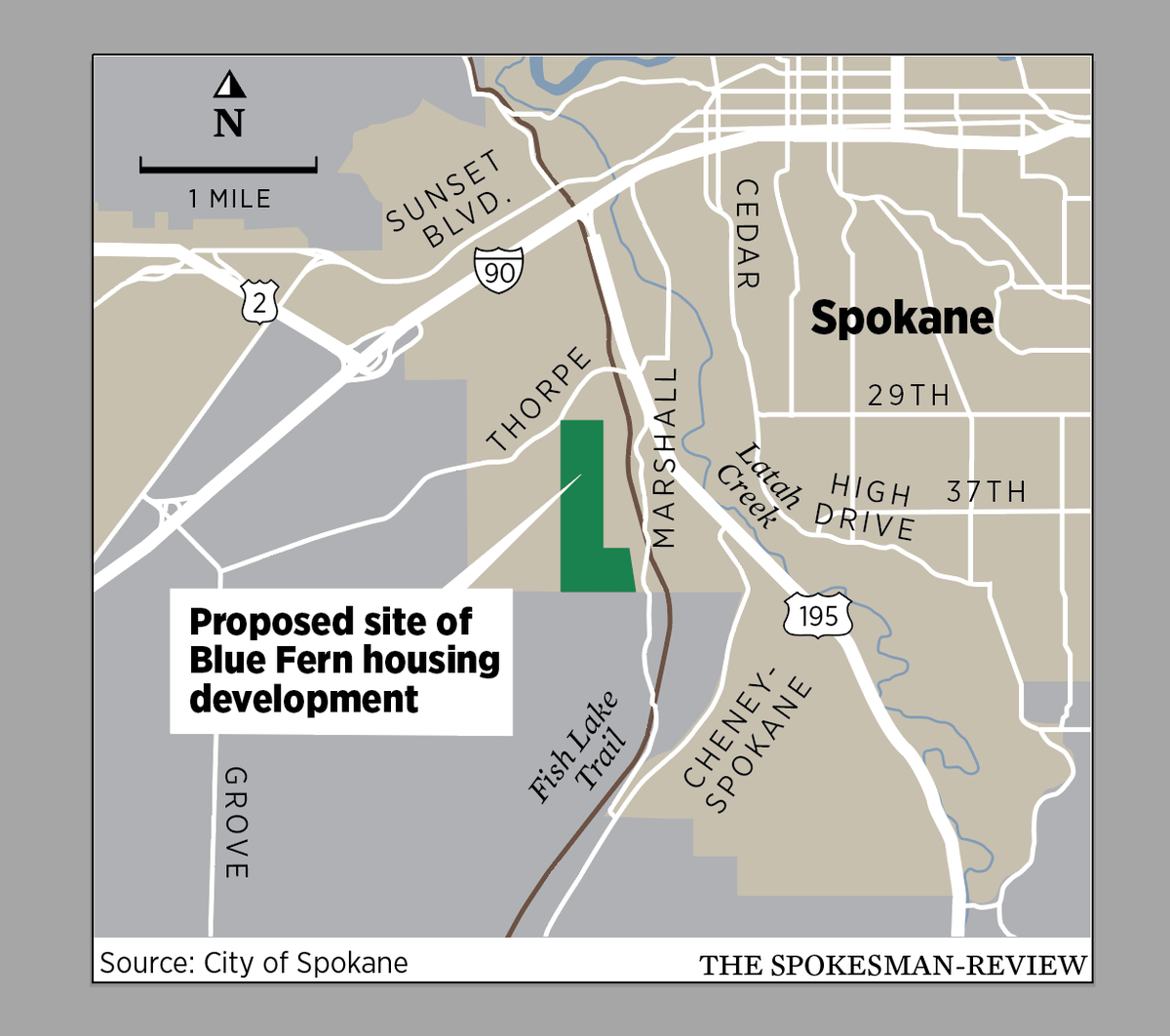Undeveloped Spokane woodland to be transferred to developer with plans to build 1,000 homes
Conservationists hope to stop as many as 1,000 homes from being built on this undeveloped land, left, shown March 24 along Thorpe Road south of Spokane. (Jesse Tinsley/THE SPOKESMAN-REVIEW)
Just more than 200 acres on Thorpe Road in western Spokane will be transferred to Redmond-based Blue Fern Management, a developer with plans to build as many as 1,000 homes on the land, after the board of the Department of Natural Resources voted unanimously Tuesday to move forward with the transfer.
Conservation activists had attempted to slow or stop the transfer, arguing the wooded area contains geological, ecological and cultural features that are increasingly rare in city limits and would be lost under the construction. Several testified to the state agency board in opposition to the transfer, and the Spokane City Council voted in December to formally ask for a delay to pursue alternatives, to no avail.
The legal transfer of the property is not expected to be completed before July 15, though the board’s decision is final, said Ryan Rodruck, a communications official for the state agency.
Councilman Paul Dillon, who had argued the property should remain undeveloped and the infrastructure of the wider Latah Valley could not easily absorb a spike in population, said he plans to use the time remaining to continue seeking alternatives, such as offering to trade other land to Blue Fern.
Under Blue Fern’s initial plans, a considerable amount of the proposed Latah Park housing development would be set aside for existing trails, a new park and some kind of civic use, such as a school, community center, firehouse or other purpose, Paulus noted. Questions remain whether the site is suited for such uses, though development on the property is years away at the earliest, Blue Fern CEO Benjamin Paulus told The Spokesman-Review in November.
Blue Fern is also the developer behind the neighboring Victory Heights project, which is already in the development pipeline and expected to bring more than 1,000 homes to the Latah Valley.
The property south of Thorpe Road is a small part of the Department of Natural Resources’ Common Schools Trust fund, 3 million acres of land managed by the agency to produce nontax revenue that pays for, among other things, building schools. This revenue is typically generated through leases, including leasing woodlands to logging companies.
The Thorpe Road property is relatively unproductive, however. It is unable to grow trees at the same pace as comparably sized land in the Cascades or Western Washington, leading the agency to pursue a trade for more profitable property, according to agency spokesman Joe Smiley.
The Department of Natural Resources also considers the area to be of low ecological importance, Smiley noted in a November interview, though local conservationists like Jeff Lambert dispute this, pointing to sections of bog, undisturbed wetlands and other features.
Generating revenue, not conservation, is the top priority of the Common Schools Trust fund program, Smiley noted in a November interview.
“It seems like an oxymoron in the title of ‘Department of Natural Resources’ when public lands are being privatized,” Dillon said Wednesday. “I think this underscores some serious flaws in our state’s process and priorities in how we view public lands.”
Dillon believes that the major residential development is shortsighted, straining already overburdened routes in and out of the neighborhood and posing a potential risk in the event of a wildfire evacuation.
“As we speak, we’re looking at horrific fires in Southern California, and a lot of those homes have been similarly built in their wildland-urban interface,” Dillon said. “We keep sprawling and building out, which puts more people at risk – we’ve seen this in the last year with people’s home insurance not being renewed in the area because of the threat of wildfire.”
The city of Spokane had attempted earlier this year to apply to a competitive program where the state could have paid DNR to transfer the land to the city at no cost. The city’s application did not make the cut, though Dillon has argued the selection process was flawed.
Beyond the potential loss of a wildlife corridor and woods, Dillon has raised concerns about adding potentially more than a thousand people – and their cars – to the Latah Valley. New development is already paused in the area after the City Council approved a moratorium in May, citing failing roads, insufficient emergency vehicle access, poor evacuation routes and a desire to address those issues before allowing new growth.
Paulus, who could not be reached for this story, has previously argued that only large development projects can generate the tax funds needed to improve the area’s neglected infrastructure.

